FW
In its latest Asian Development Bank (ADB) report has maintained its April projection for Cambodia's economic growth at 7.1 per cent in 2017 and 2018. The Southeast Asian country's growth is mainly driven by garment export, tourism, agriculture and construction.
Cambodia's economy continues to expand at a robust pace, propelled by export diversification, strong construction and tourism activities, better weather conditions, and supportive fiscal policy, Samiuela Tukuafu, ADB Country Director for Cambodia.
According to the lender's updated report, merchandise exports as indicated by customs data rose by 7.7 per cent and imports by 8.1 per cent in the first half of 2017. The report also stated that inflation averaged 3.3 per cent in the first seven months of 2017. Adding that per month, inflation was highest at 4.2 per cent in March and lowest at 2.3 per cent by July due to softer fuel and food prices.
The average inflation is forecast to come in at 3 per cent in 2017, and edge up marginally to 3.2 per cent in 2018.
"The popularity of Bangladesh RMG is such that every third European has a T-shirt made in Bangladesh and every fifth American wears jeans manufactured in Bangladesh. The country exports $28.14 billion worth of the item or 6.4 per cent of the global share and the export target by 2021 is to push it up to $50 billion. This looks achievable knowing China has shifted its focus from textile to services economy. Amid all these, a question to ponder over is at what cost does this economic development happening? A study by International Finance Corporation (IFC) reveals, every year, 1,500 billion litres of water is used to dye and wash the cotton and clothes for the garment industry. "

The popularity of Bangladesh RMG is such that every third European has a T-shirt made in Bangladesh and every fifth American wears jeans manufactured in Bangladesh. The country exports $28.14 billion worth of the item or 6.4 per cent of the global share and the export target by 2021 is to push it up to $50 billion. This looks achievable knowing China has shifted its focus from textile to services economy. Amid all these, a question to ponder over is at what cost does this economic development happening? A study by International Finance Corporation (IFC) reveals, every year, 1,500 billion litres of water is used to dye and wash the cotton and clothes for the garment industry. This is enough to fill up 600,000 Olympic swimming pools. This water can meet the demand of 8 lakh people for a whole year. For the average jeans, one wears that weighs 1kg, it takes 250 litres of water to wash. This is not at all hard water we are talking about. It’s all drinking water, pumped out from underground.

When such a huge quantity of water is pumped out, a hollow underground is created. As the hollow grows, it creates chances for the earth to cave in. As more and more water is pumped out, the water table goes down. The classic example is Dhaka where every year the water level is dropping by 2.5 per cent. Considering that water table is not infinite, a real disaster will take place sooner.
Increasing pollution levels
The worst part is the garment industries discharge water into rivers and canals after use. This makes the water highly polluted with toxic chemicals and dyes. Bangladesh has around 789 dyeing and finishing factories to serve some 4,000 garment factories, according to the IFC, consuming major part of underground water. If these industries can attempt at reducing water consumption by a fourth with the help of technology, it could drastically reduce the use of chemicals. Additionally, more water needs more gas to heat for the dyeing and finishing of fabrics. Gas, again is a scarce commodity, which is adding to the crisis.
Possible solutions
While Bangladesh uses 250 litres of water, the global standard is 60 to 70 litres for a single pair of jeans weighing 1kg, implying that the country is using four times more water. Experts say, water usage still be brought down to 13.5 litres. For example, every year, around 21.6 million cubic metres of water were saved by the intervention of Partnership for Cleaner Textile (PaCT) programme of the IFC, which worked with 200 factories. According to Nishat Shahid Chowdhury, programme manager, PaCT, these 200 factories could save $16 million a year just by reducing water consumption.
Bangladesh is now conscious about this fact and some companies have started taking positive measures. Earlier Fakir Apparels used 24.96 crore litres of water to wash and dye 1,200 tonnes of fabric a month. But after changing technology, it has reduced water usage to 6.96 crore litres, thereby saving 70 per cent water. The company even recovered its investment of $2.65 lakh in six months. Likewise, Mondol Fabrics has been able to save 27 per cent of water by using new technologies. It needed 120 litres water to process one kg of fabric. Now it needs 80 litres only. It is working to cut down water use further by putting in more technologies.
"For Bangladesh RMG exports, shirting has been a key growth driver over the years. This was complemented aptly by knits and bottoms (non-denim and denim) that helped the country strengthen its position as the preferred global textile sourcing destination. Looking at the increased efficiency and expertise, major MNCs such as H&M, US retail giant Walmart, British retailer Primark, Germany’s posh brands Hugo Boss and Olymp (formal shirts), and many more, have made Bangladesh their preferred sourcing destination."

For Bangladesh RMG exports, shirting has been a key growth driver over the years. This was complemented aptly by knits and bottoms (non-denim and denim) that helped the country strengthen its position as the preferred global textile sourcing destination. Looking at the increased efficiency and expertise, major MNCs such as H&M, US retail giant Walmart, British retailer Primark, Germany’s posh brands Hugo Boss and Olymp (formal shirts), and many more, have made Bangladesh their preferred sourcing destination.
Statista’s data reveals, the global shirt market stood at $51 billion with total consumption of 2.5 billion pieces in 2016. This is further expected to reach $58.5 billion (in value terms) and 2.83 billion pieces (in volume terms) by 2020. Bangladesh has a key role to play in this growth. The country contributed around 10 per cent to the total global shirt import in 2016. But despite this growth, shirt as a category has somehow failed to keep pace with growth of other products. As Khondoker Mahibur Rahman, MD, Stanley Fashion explains that of late they are getting more demand for sweaters, jackets, denim and other products which found base in Bangladesh after shirts.

Shirts losing ground Even the recent BGMEA data reflects the industry sentiments. In 1996-97, the export earnings from shirts was $759.57 million, while for trousers, jackets, t-shirts and sweaters, the value of exports were $230.98 million, $230.98 million, $391.21 million and $196.6 million, respectively. In 2015-16, in terms of value (export), shirt stood at $2,317.09 million while trousers, jackets, t-shirts and sweaters registered drastic growth to touch $6,319.00 million, $3,774.08 million, $6,118.53 million and $3,182.47 million, respectively.
The growth of denims is one of the key reasons of falling demand for shirts, say experts. Rahman also says about 75 per cent of demand is for denim today. The way the industry has been investing in denim is unprecedented, no other product has grown like this and today the country has integrated strengths that did not exist about a decade ago, and this has been pushed by buyers who now look at Bangladesh as a major supplier, both in basic and fashion segment. As Md Khosru Chowdhury, Chairman & MD, NIPA Group, points out in shirts, which was once the company’s biggest category, casual denim shirts are witnessing greater traction. Moreover, there is no real focus on the category as there are many players in the segment and the price offered is competitive.
A ray of hope
Statista predicts, if global demand for shirts stands at $53.36 billion (in terms of value) and 2,580 million pieces (in terms of volume) in 2017, the same would register a steady increase in coming years to touch $55.17 billion (in value terms) and 2,657 million pieces (in volume terms) by 2018, to further increase to $56.8 billion and 2,740 million pieces respectively by 2019. While challenges exist, there are still some players who are going strong. According to Maashed R Abdullah, Ddirector, Dressmen, the business is more difficult these days as customers are not realising how much effort is put into manufacturing quality products. Prices have dropped significantly but customer’s demands are increasing one needs to find a middle ground where customer and the manufacturer stand to gain.
Many feel shirt business is not at its best today. Compared with other RMG products, shirt is not in the frontline of Bangladesh exports any more. The fact is the country has failed to explore markets for shirts. To grow in shirts, they would have to find new customers and markets. Additionally the price from buyer must be increased; otherwise it would be difficult to survive. There is 50:50 demand for both casual and formal shirts. Men’s formal and casual shirts, ladies blouses, school shirts are items that are seeing greater demand.
MarediModa presents Trends Summer 2019 for Swimwear/Intimate Apparel/Athleisure Fabrics and Accessories, theme for teh season is Exploring the new without leaving the past. The trends forcasting is done by Trend forecasting by David Shah and Stijlinstituut Amsterdam.
Ad hoc (Swimwear)
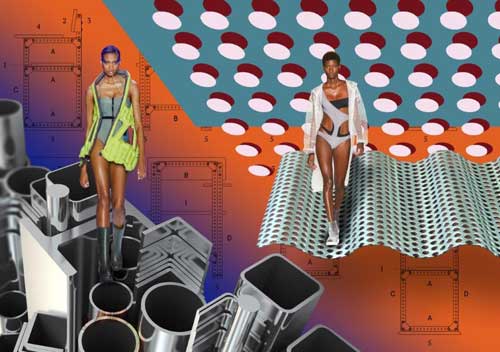
An ad hoc, dynamic design process gives the freedom to pick, mix, colour and layer. Modular outfits combine and connect in new ways to morph from swimwear to sportswear to anywear. Fabrics: fabrics are selected to provoke creativity and industrial ambition in design. Choose compact, functional swim and sports fabrics, either plains or with surface or knit-in designs - grids, meshes and heather effects - to represent construction materials. Patterns: think retro construction toys, then mash that with computer graphic patterns, laser cut holes, printed meshes and rhythmic graphic patterns and jacquard weaves. Colours: Meccano shades without the flatness of pure primaries - these are more sophisticated mid-tone brights to colour block with sturdy darks and hazy pastels. Silhouettes: a hard-core sporting foundation for a fun-filled lifestyle. Styles are bold, sporty and graphic.
Next Nature (Swimwear)
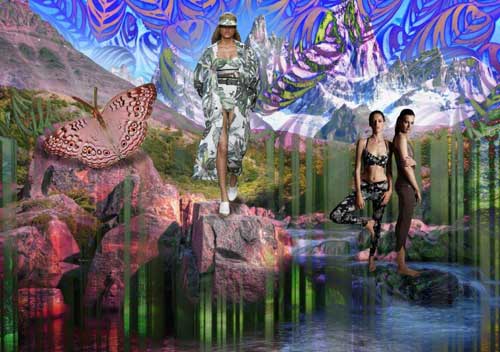
Take a holistic approach, considerate of the full process from ethical sourcing, integrity of design, production methods and disposal after use. Fabrics: manmade, inspired by nature, these smart fabrics mimic nature’s sophisticated aesthetics and intelligence. Surfaces are smooth skin, fur or carapace. Patterns: the forest inspires with tonal palm leaves and feathers. Natural irregularities are mimicked using digital language to create magic marls and natural stone effects. Colour: deep natural shades combine urban and natural environments. Forest shades feature with dense pines and cedars, utilitarian khakis, browns and burnished terra tints. Silhouettes: covered silhouettes provide space for hyper-scale patterns. To contrast we propose styles that help nature by shaping the body using body-tuning cuts and tailoring.
Artful (Swimwear)

Traditional folk craft skills can be re-interpreted or blended with high-tech computer graphics for a synthesis between nostalgia and optimism for a global future that is refreshing and exciting. Fabrics: cotton-touch fabrics contrast with skin-touch materials. Basic charmeuses sit alongside crochets, plissé, piqués and honeycomb effects. Patterns: wildly innovative, colourful, fun and bold. Small retro-inspired graphics mix with free-spirited Memphis inspired patterns. African patterns mix with cut and pasted stripes. Colours: fresh, bright hues for bold plains or clashing contrasts. Bright colours are used to collage and create happy harmonies. Silhouettes: Pretty bras and briefs are intimatewear for swimwear.
Into the cloud (Swimwear)

Today’s fabrics reach for the clouds with futuristic prints and fibre performance stories. Fabrics: experimentation in intelligent, multi-disciplinary design and manufacturing leads to hyper-dynamic plissés, responsive and sensory materials, fabrics that protect you from paparazzi and warn you of air-born hazards. Patterns: the consumer can co-create: Multi-colour gradients, psychedelic and slightly intergalactic, have the attraction of flowing liquids. Colours: acid and glowing shades where gradient colouring and rasterized patterns add to the virtual and meditative appearance. Silhouettes: experimental novel garment manufacturing methods include 3D printed details and accessories. Fit is optimised using body-scanning technology.
Active Reactive (Intimate Apparel)
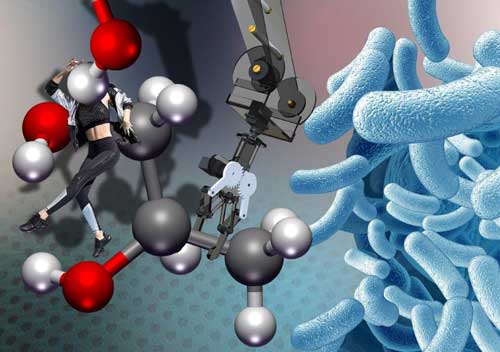
Garments containing personalized health solutions and beauty boosting properties. Fabrics:go lighter, go longer: an exploration of ultra-light support and maximum comfort in breathable fabrics that fit like a second skin or provide compression to improve performance. Patterns: graphic patterns, graduated or engineered effects aid function as well as look. Colours: a palette of contemplation, pure and neutral for energetic performance and active intimate looks. Silhouettes: 3D data modelling and prototyping offer extreme comfort or graduated compression in intelligent layers.
Dress up (Intimate Apparel)
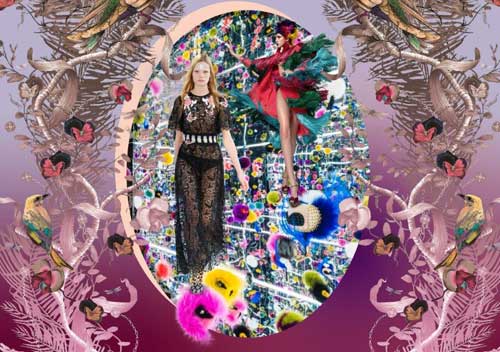
Used garments and waste materials from the fashion industry are recycled and even more valuable as a result: the appreciation of the value of life includes the environment we live in. Fabrics: fabrics take the lead, they are the story and they are intricately embellished, beaded, sequined, fringed, encrusted or ravishingly printed. Patterns: flowers and ornaments. The source is traditional, yet re-worked in modern designs and combinations. Colours: warm and rich in royal reds and blues that combine or vibrate against corals, gold, purples and deep burgundy reds. Silhouettes: from corsetry-inspired classics to activewear innovation, shape solutions are complex.
The Green Carpet fashion awards brought star power to fashion’s drive to sustainability.
The unique awards put sustainability at the heart of fashion in a ceremony fit for the Oscars.
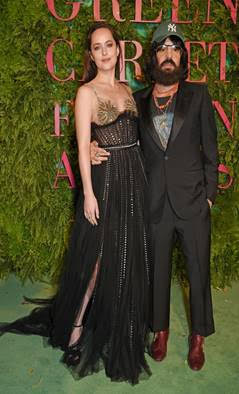
Dakota Johnson wore a Gucci black organic silk tulle dress with Swarovski crystals and recycled brass embroidered cups. Swarovski crystal embroideries were also featured on the straps, bodice, belt and skirt.
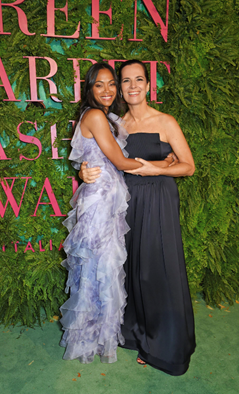
Zoe Saldana wore a timeless Giorgio Armani Privé look. The 100 per cent silk dress was handmade in Italy.
Roberta Armani wore Giorgio Armani. The dress was 100 per cent silk GOTS certified silk from Clerici.
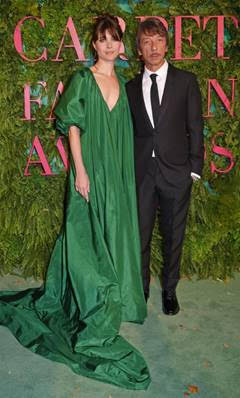
Vittoria Puccini was wearing a dress created using Italian end-of-line upcycled taffetas silk and certified organic silk lining. The metal components were reclaimed and covered with silk offcuts.
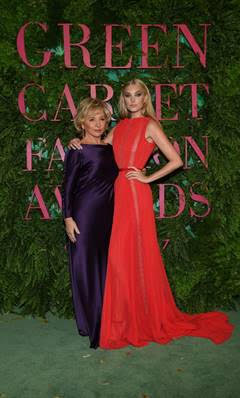
Elsa Hosk was wearing a breath taking Alberta Ferretti gown created from certified organic silk chiffon. The gown features lace detailing from factory deadstock which was hand-dyed. The zips were reused from old samples to ensure nothing goes to waste.
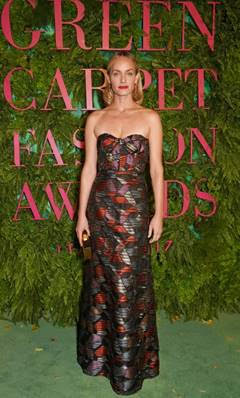
Amber Valletta was wearing a Missoni which incorporates intricate hand embroidery and bustier boning upcycled from an old dress - a perfect way to reuse materials that could otherwise be forgotten or even end up in landfill. The Italian produced silk base is certified GOTS organic, with a zip made from recycled polyester.
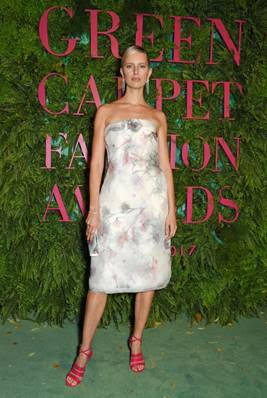
Karolina Kurkova was wearing Ferragamo, a dress embroidered with floral applications with lead-free advanced crystals from Swarowski, used to give light and emphasize the flower embroidery. The outfit was made of silk organza woven and printed with GOTS certified fibers.
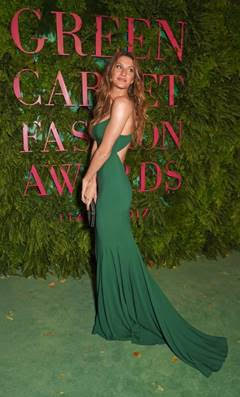
Gisele Bundchen was in a bespoke emerald green goddess gown by Stella McCartney, crafted from sustainably sourced viscose from sustainably certified forests in Sweden.
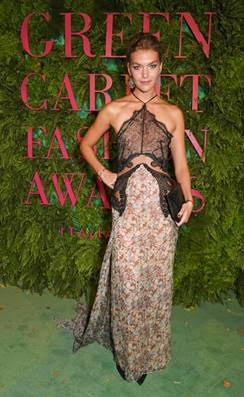
Arizona Muse was in a bespoke print gown with handmade lace detailing by Stella McCartney, crafted from recycled archival print fabrics.
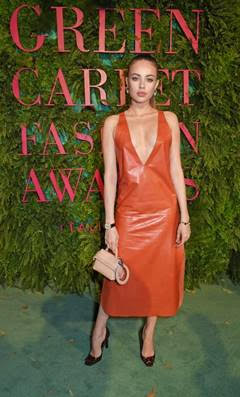
Xenia Tchoumitcheva was wearing Tods. The piece was created from unused archive leather that was originally used to research and test terracotta dye colors. This leather was reworked and upcycled into a simple sheath dress.
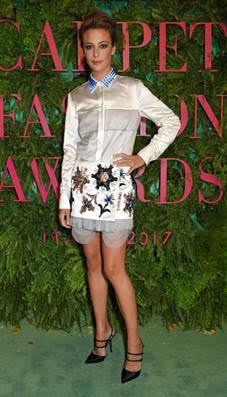
Jasmine Trinca was wearing Prada. This look was made using the highest quality Italian produced silk, featuring certified organic silk organdie, lead-free Swarovski crystals and flower embroideries created out of silk offcuts from the cutting process.
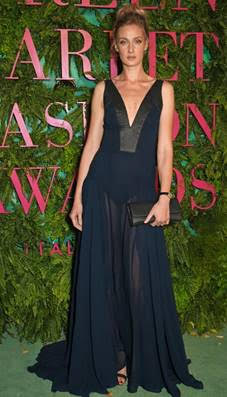
Eva Riccobono was wearing a stunning Trussardi gown made from organic Italian silk, featuring Piñatex, a natural leather alternative made from unwanted pineapple leaves. Piñatex provides a new, additional income for farmers while creating a vibrant new industry for pineapple growing countries.
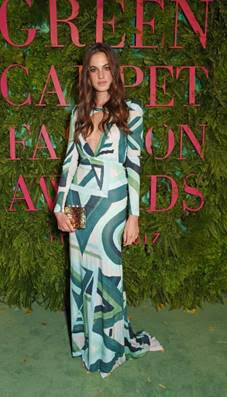
Matilde Rastelli was wearing an archive Emilio Pucci dress. Bringing out pieces from the archives for events is a wonderful way to be more sustainable through not using new materials, but it also allows stunning pieces to continue to be worn, appreciated, and admired.
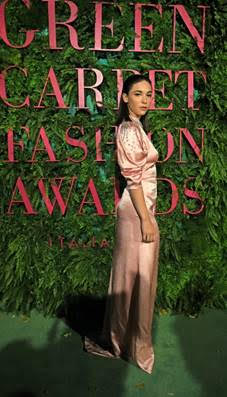
Matilda de Angelis was wearing a stunning Miumiu gown crafted from GOTS certified organic silk crepe satin, produced and finished in Italy. The dress is embellished with certified Swarovski advanced elements lead-free crystals, ensuring a responsibly made look with minimal impact.
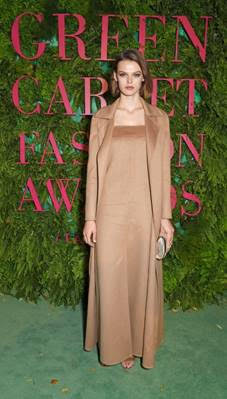
Cara Taylor was wearing a Max Mara, made of camel hair fabric, sourced from Inner Mongolia. The thread, label, and zip for this look were all made from recycled polyester.
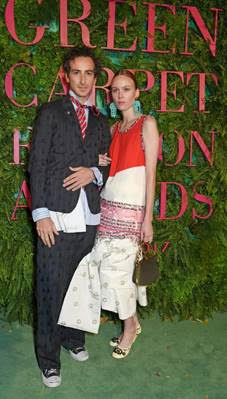
Kiki Willems was wearing Marni, in a stunning look which is made from certified organic silk in many guises - delicate silk crêpe, silk faille, and luxurious crêpe satin. These Italian fabrics have all been certified by Global Organic Textile Exchange, which is the world’s leading processing standard for textiles made from organic fibers.
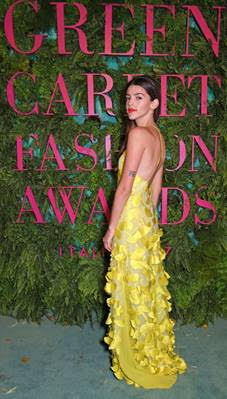
Calu Rivero was wearing a dress made from an Italian silk and Newlife jacquard with exclusive Laura Strambi’s design. Newlife is a completely Italian recycled polyester, created from used PET plastic bottles. These are sourced, mechanically processed and spun into yarns in Italy, with a fully traceable supply chain. This saves energy and reduces CO2 emissions compared to creating brand new polyester fiber.

Kasia Smutniak was wearing Fendi. The materials from this look were selected from Fendi archives so that no new materials have been produced.
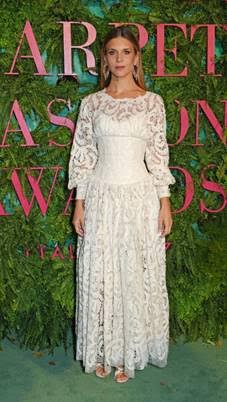
Nicoletta Romanoff was wearing an Ermanno Scervino dress crafted from the highest quality GOTS certified organic silk, with carved embroidery. The carved embroidery is a handmade technique also known as Guipure. This kind of embroidery became very popular in Italy between the XVI and XVII centuries, and was originally used for trousseaus and linen.
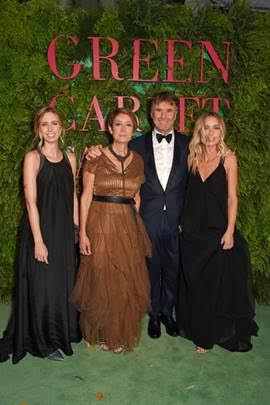
Camilla and Carolina Cucinelli were both wearing Brunello Cucinelli. Brunello’s vision entails that the memory of an important humanistic factor such as craftsmanship is preserved and passed on to future generations.
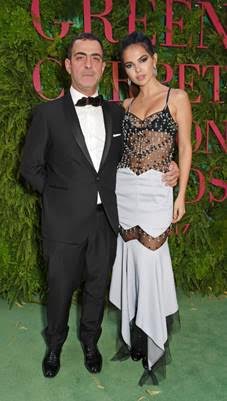
Doina Coibanu was wearing Antonio Berardi. This look has been made by recycling a vintage Bernardi toile, and is made from antique Italian tulle, and vintage Swarovski crystals.
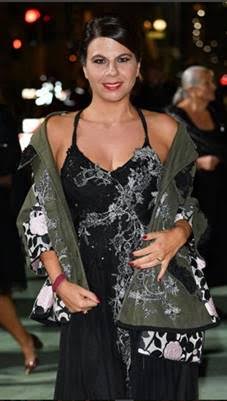
Geppi Cucciari in an Antonio Marras look featured a vintage military parka which has been cut, modified and embellished with special jacquards and precious embroideries. The stunning dress was made from GOTS certified organic silk chiffon and crepe de chine.
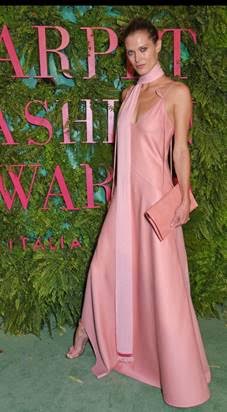
Malgosia Bela was wearing a beautiful Agnona dress. The cashmere is sourced from Mongolia and entirely processed (washed, combed, woven, teased) in a wool mill in Italy.
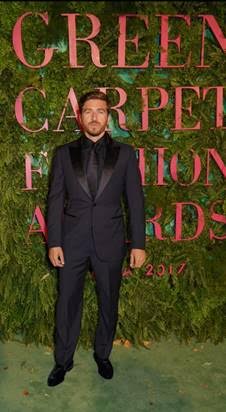
Alessandro Roja was wearing a Zegna navy blue tuxedo made from Zegna’s Achill Farm wool. Ermenegildo Zegna has had a longstanding relationship with farmers in Australia and New Zealand, and now has its own farm, Achill. The land is kept in line with Ermenegildo Zegna’s recognition of its duty as a custodian of the landscape and its commitment to respect the environment.
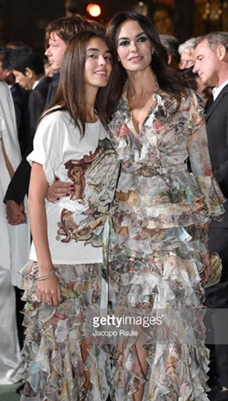
Maria Grazia Cucinotta was wearing a Laura Biagiotti. This gown was colored with natural vegetable dyes, featuring handmade ruffles created by experienced seamstresses in the Laura Biagiotti atelier.
Powermax, a high-end smart technology products producer and Mianyang Weibo Electronic Co., Ltd. signed officially strategic cooperation agreement during the opening day of CISMA 2017, opening a new chapter in the sewing machinery industry.

The signing ceremony was held in presence of He Ye ( Director of China National Sewing Machinery Association), Yang Xiaojing (Vice Director of China National Sewing Machinery Association), Chen Ji (General Secretary of China National Sewing Machinery Association) and Liu Yong (Chief of Automation Research Institute of China Weapon Equipment Group) .

He Ye affirmed the achievements of Powermax and Weibo, she pointed out that Powermax and Weibo are "vanguard of industrial enterprises" in the field of sewing machinery industry units, they are the leading suppliers of sewing equipment series . “While contributing to the technology innovation, Powermax also set off a new revolution on global customer service . In three years, the company has established 1000 technical service centers, trained 1000 people as qualified maintenance personnel.” She added.

Powermax also signed authorization agreement on the spot with 10 foreign technology centers and 20 domestic technology centers including MAHALA、Sokkar For Sewing Machines、KO.VIWAT、 Welttec、 Sun Special、Sheng Da Electronic Technique Co., Ltd、 Myanmar Jie Yao Trading CO., LTD 、Hong Phi Export & Import CO., LTD、United Machineries、KECOGLU MAKINA SAN.VE, TIC.A.S、 and others, enabling the company to cover more than 10 countries, and have more than 200 domestic technical centers.
UL is the latest company to join the Sustainable Apparel Coalition (SAC). It will use the group's sustainability measurement tool, the Higg Index, to drive environmental and social responsibility throughout its supply chain. The Higg Index is an open sourced, indicator-based tool that allows suppliers, manufacturers, brands and retailers to evaluate materials, products, facilities and processes based on environmental and product design choices.
In its relationship with the SAC, UL will contribute both data and resources to support the Higg Index, which measures sustainability performance and drives supply chain transparency and decision-making to better efficiency and sustainability impact.
UL partners with clients to support them with every aspect of sustainability and supply chain management, including developing a proactive stance and demonstrating green and sustainable credentials, assisting in gaining better visibility into supply chain issues and mitigating risk and implementing customized and comprehensive environmental management systems.
UL helps companies demonstrate willingness to invest in the long-term future of the business through sustainable supply chain practices and assists them in gaining a competitive advantage through sustainability initiatives and implementation of best practice procedures.
Indian textile and apparel industry members of SAC include the Aditya Birla Group, Eastman Exports Global Clothing, Pratibha Syntex, Arvind and KG Denim.
CISMA 2017 opened yesterday here in Shanghai on Sept. 26, 2017 at Shanghai New International Expo Center, among the large gathering of Chinese government officials, including Zhang Chonghe (Chairman of China Light Industry Association) , He Ye (Chairman of Chinese Sewing Machinery Association) , Chen Dapeng (vice president of China Textile Industry Association and chief vice president of Chinese Garment Association), presence of global sewing machiery association leaders from Japan, Germany and the United States, and industry representatives. More than 100 people attended the opening ceremony.
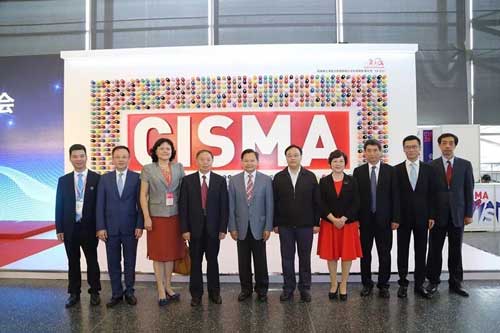
HeYe, Chairman of China Sewing Machinery Association, summed up the achievements gained by sewing machinery industry in the digital, intelligent technology innovation and application marking the beginning of this new round of industrial revolution. She pointed out that the CISMA2017 improves and enhances the comprehensive system of internationalization、specialization、and information of trade, information and communication ,thus boost the technology communication and industry linkage very much.
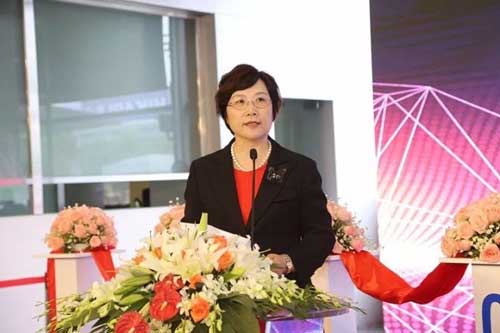
She assured CISMA will expand service, create value with the open mind like “all rivers run into sea”. “In the new journey of the ‘The Belt and Road Initiative’, under the guidance of the spirit of the Silk Road, CISMA expects to reach win-win co-operation in smart sewing” she summed it up.
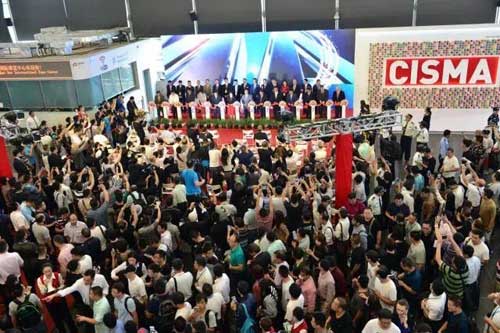
CISMA 2017, that opened today is showcasing the most advanced equipment and technical achievements of the industry in twelve exhibition halls. More than 1200 exhibitors from 24 countries and regions are going to meet face-to face and carry out communication and demand pairing with more than 50,000 professionals from more than 100 countries and regions through multiple media such as offline, online etc.

Two years ago, CISMA came up with the idea of revolutionary theme of Intelligent Sewing Solutions. It ushered in a new round of global sewing machinery technology and industry transformation. And now, two years later CISMA 2017 continued to focus on intelligent sewing machinery developments.
This edition of CISMA has further strengthened the organization of customers from overseas and the downstream industry. Professionals and garment associations from Pakistan, India, Sri Lanka and China, China Home Textile Industry Association, China Industrial Textiles Association, China Leather Industry Association, China Furniture Association, and other institutions and trade associations are expected to attend CISMA 2017.

Intelligent technology- a new industrial revolution
Since the launch of a new industrial revolution, the sewing machinery industry has become the global focus, becoming a model of digital, intelligent technology innovations and applications in many fields. The industry, whether in the unmanned manufacture of parts and components, or in the development of smart sewing equipment and sewing production lines, has made remarkable achievements in integrating multiple industrial platforms, while at the same integrating consulting, designing, manufacturing, warehousing and service in a single body and covering the related upstream and downstream industrial sectors.

The humanized smart sewing factory is also being transformed from a mere idea into a substantial, sensible and usable reality, which is widely used in the downstream fields of clothing, home textiles and leather.
In China, transformation and upgradation of the industry have been carried out effectively. The industry has developed vigorously and its status has improved significantly. The sewing machinery industry has become a typical equipment of intelligent manufacturing in light industry. Multiple product and projects are included in the national smart manufacturing pilot projects. The industry is rapidly changing from simple daily and industrial machinery manufacturing to overall solutions and value-added services.
A river in China has turned blue, an indigo blue, all from the pollution of making blue jeans. In Bangladesh, tannery workers with no protective clothing treat leather with noxious chemicals, before dumping the runoff into the river. Further downstream, people bathe in the same waters that are deep black, orange, purple. Children in these areas are not able to smell and skin diseases – rashes, ulcers, boils – are widespread. Pollution, often carcinogenic, enters the food chain too: boatmen bring a haul of fish to shore, which they find floating on the surface of the black water, dead.
This is a systemic problem, driven in part by consumer demand for cheap clothing in wealthier countries. The developed world embraced free trade in the 1980s and 90s, resulting in the closure of the biggest textile factories in America and Europe, previously the hubs of global production regulated by strict pollution laws. The textile and leather industries were just two of many pollution-heavy industries that shifted across the planet towards the end of the twentieth century.
In pursuit of lower priced goods, higher profit margins from cheap labor, and nonexistent regulations, factories sprang up in China, India, Bangladesh and Indonesia. Simultaneously, demand, production and pollution ballooned as the west embraced the hedonistic rush of no-strings-attached cheap clothing.











